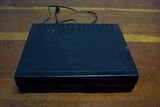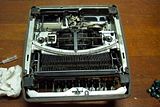This specimen is as good an example as any of the crapshoot nature of sewing machines. On the one hand, it's relatively new, so there might now be so many mechanical bits to salvage, but on the other hand, a lot of whatever parts that are inside are plastic and thus less of a pain on average to remove. So, going into this, I didn't have too many expectations one way or the other.

Like I said, it's a fairly new sewing machine, and I wouldn't be surprised to find out it was still available at retailers. It also appears to be a low-end model, to make an uninformed snap judgment, and was thus probably cheaper to replace than to fix.
One other thing of note is the design of the little slider things on the setting levers. As far as I can remember, I don't have anything else of a similar shape in my parts collection. And knowing how I think, they'll likely sit unused for a very long time for fear of messing up the only ones of those I have.

Yet another free spool of thread. And this time it's actually in a color I can possible use, you know, if I ever figure out how to sew.

I kept the whole thing. One day, I'll probably get tired of oddly shaped plastic boxes, but that day hasn't come yet.

Fairly clean interior for a new sewing machine.

Note the exposed ends of those wires. They were originally hooked into a connector. I always try to pull those kind of circuit board connectors that plug into the little pins, but they rarely come off cleanly. This sewing machine, however managed to yield several of them with little effort.

Not an impressive haul in number of parts, but some of what I got are somewhat unusual.


















